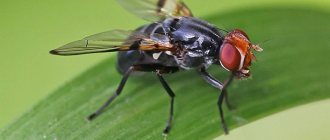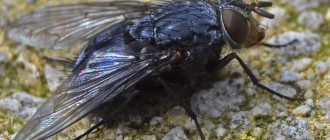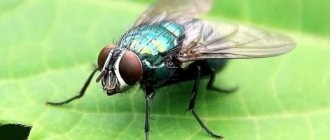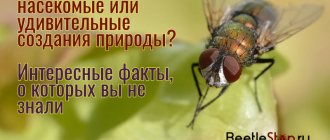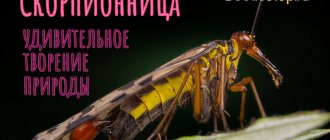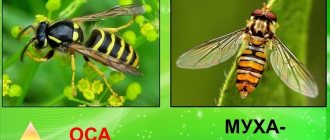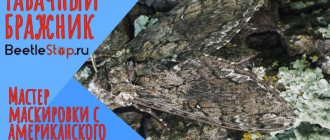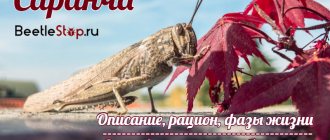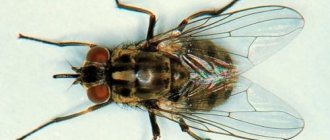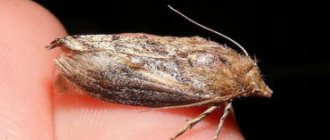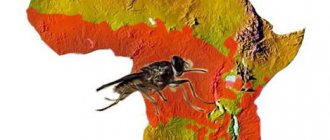Insects are a significant nuisance to humans. Flies are one of the most common uninvited guests in our homes.
It is not for nothing that this dipteran is considered a symbol of importunity. However, flies are not only annoying with their presence.
Autumn fly
They also pose a danger to human health. At the end of summer, one of the species of this family of insects, the live fly, becomes active.
Outwardly reminiscent of its usual domestic counterpart, this one is much more dangerous, as it is capable of leaving serious bites on the human body.
Description of the autumn burner
In appearance and in its habitat, this insect is almost no different from another synanthropic species: the housefly. These two species have the same body size (5.5-7 mm) and very similar coloration. In the photo, only a specialist can distinguish a live fly from a house fly. Both dipterous insects are gray in color. There are longitudinal black stripes on the chest.
On a note!
But the color of the zhigalka’s abdomen is different: it has dark spots on the upper part of the abdomen, and the lower part is also gray. The housefly's abdomen is yellow underneath.
The difference between a male and a female is the same as that of a housefly: females are larger and their eyes are set wider apart than males.
The autumn zhigalka also has differences from its double. In a calm state, the wings of the burner are spread wider than those of the indoor one. The proboscis is located in the same way as that of the tsetse and is directed forward.
Why is it dangerous for humans?
Diseases transmitted by the zhigalka
Like any “reusable” bloodsucker, the zhigalka is capable of transmitting dangerous diseases to humans:
- relapsing fever;
- tularemia;
- trypanosomiasis;
- ehrlichiosis;
- anthrax.
Flies often land on decaying carrion, catching pathogenic bacteria on their legs and proboscis. In this case, when feeding on blood, they can introduce bacteria into the wound. But the risk of sepsis in this case is minimal. The human body is able to resist a small number of pathogenic bacteria. Microorganisms brought from carrion are dangerous only to people with a dysfunctional immune system.
On a note!
The transfer of dysentery pathogens and worm eggs is a common function of all flies, including the autumn flies.
Lifestyle
The “just in time” insect has now spread with humans throughout the world. There are no zhigalki only in the Far North. In the process of evolution, the species has adapted to feed larvae in animal droppings. With the advent of civilization and animal husbandry, the zhigalka almost disappeared in nature, moving to a warm barn. For her passion for human habitation, she even received the nickname “village girl.” But this adjective is added to any synanthropic species of dipterans.
Interesting!
The insect has not lost its ability to survive in nature. The proof is in the population found in the pelican colony.
Next to a person, the zhigalka found an ideal habitat for itself. In the barn the table is always set for her and shelter from the cold is ready.
Control measures
To prevent the appearance and spread of autumn fireweed, the following measures are used:
- Timely removal of household waste;
- Asphalting areas for garbage containers;
- Concreting floors and equipping drains for liquid sewage on poultry and livestock farms;
- Installation of equipment for flushing sewage with water;
- Screening windows in the warm season;
- Compliance with sanitary rules in food enterprises.
Mechanical pest control methods
- Thorough cleaning of premises;
- Fishing in traps with bait;
- Fishing with sticky tape containing an attractant that attracts insects;
- Use of protective nets and curtains.
Mechanical methods are not the main methods of controlling flies, since they cannot prevent the spread of flies and provide complete protection to people.
To exterminate fly larvae and pupae, it is recommended to use various larvicides in the form of emulsions based on active substances of various chemical classes.
To exterminate adult flies, insecticides of all known groups are used. Poison baits, sticky tapes and sheets are widely used.
Resistance of flies leads to the use of mainly food poisoned baits.
Nutrition
Zhigalki are obligate bloodsuckers, in which both sexes feed on blood. Their main food items are horses and cattle. The proboscis of insects is adapted for obtaining nutritious liquid. At its end there are “teeth” with which the parasites scrape off the top layer of skin.
Fly fly
When feeding, the parasites release saliva into the wound with anticoagulating properties. The substances that make up the salivary secretion cause a burning sensation in a person where they come into contact with an open wound.
On a note!
The female needs blood to produce numerous offspring. Her abdomen is designed in such a way that she is able to drink a volume of blood that is 2 times her weight.
The larvae develop in animal excrement. Sometimes the zhigalka lays eggs in rotting vegetation. Cases have been recorded when a fly tried to lay eggs on open wounds of a person or animal.
Habitat
Autumn flies are not picky and do not require special conditions. The main thing is that it is light and warm. That is why they are common almost everywhere.
The main places for the accumulation of livestock are pastures, cattle pens, and barns. Here the flies feel very comfortable, because there is both manure for laying and potential food - the blood of livestock. Flies feed only on blood, and at one time they are able to suck out an amount twice their own weight.
In warm weather, firebirds often bask on the sunny side of house walls and tree trunks, but once indoors, light-loving firebirds still try not to be seen too much, hiding in the shadows or behind and under furniture (this is why firebird bites often occur on the legs).
Life cycle
Zhigalki are capable of leaving for the winter at any stage of their development. But most of them freeze during frosts, although in southern countries they can reproduce all year round. At temperatures below +8 degrees, insects fall into stupor. After spring warming, flies begin to experience another population increase. In spring and early summer, due to the small number of flies, they are not noticeable. But this species is reproducing at record speed.
A female can lay up to 400 eggs in her life. The full development cycle at the optimal temperature for the species of +27-30 degrees takes only 5 days. The larva that emerges from the egg burrows into the manure and goes through all 3 stages of development there. During this time, it grows in length by more than 10 mm. At the last stage it pupates.
What harm does
Carrot pests are larvae, which, if left unchecked, can cause serious damage to the crop. Eggs and larvae end up in storage during harvesting and continue to eat carrots in the winter. Even slightly infected specimens lose their taste and quickly rot.
A small fly is difficult to notice near the beds. Signs of infection of plantings and fruits:
- change in the color of the tops - the leaves become an unnatural red-violet color, gradually turn yellow and dry out;
- when the top of the carrot is exposed, brown dots from the movement of the larvae are noticeable;
- the extracted carrots are covered with brown spots and have an unpleasant odor;
- the fruits are twisted and deformed.
Pathogenic microorganisms and fungal spores penetrate through the damaged surface. The carrots rot right in the ground, the green part dries out and falls off. Even a fruit that is not completely dead becomes unsuitable for food - the flesh becomes coarse, there is no juiciness and aroma.
Bite danger
Poisonous saliva, entering the skin, causes severe burning and irritation. If there are a lot of fly bites, an allergic reaction may develop. Under normal conditions, the affected area swells, itches and turns red. When scratching, the poison spreads further through the skin.
Important!
But it’s not even the bites that are dangerous, but the autumn flies themselves, which are carriers of many types of diseases. Since they live all over the globe, they can carry any “local” blood-borne diseases. If the area is not free from tick-borne encephalitis, the zhigalka will also transmit encephalitis. And even more likely than a tick.
All flies are mechanical carriers of staphylococci and polio, and when bitten by a flies, they can also transmit:
- tick-borne encephalitis;
- babesiosis;
- anthrax;
- tularemia;
- sepsis;
- other diseases.
Tsetse
- This fly has twice as much vitamin C as a regular fly (just kidding)
- African viviparous blood-sucking fly: carrier of sleepy and some other diseases
- another name for the African fly, glossina
- a genus of blood-sucking flies, common in the tropics and subtropics of Africa
- fly with vitamin C
- bloodthirsty African fly
- this fly was the first link in the chain of evidence that Jules Verne's heroes ended up in Africa, and not in America
- insect, fly
- fly in Africa, carrier of sleepy and some other diseases
- fly from Africa
- African fly
- bloodthirsty fly
- “fly with vitamin C” (anecd.)
- African fly in the service of Morpheus
- fly biting Papuans
- fly
- African pest fly
- sleep-inducing fly
- African clatter fly
- imported clattering fly
- African fly as a sleeping pill
- African fly - “hypnotist”
- sleepy fly
- fly from Zanzibar
- the clattering fly is native to Africa
- dangerous fly
- dangerous African fly
- African fly as a hypnotist
- African fly as a hypnotist
- African fly as a sleeping pill
- African sleepy fly
- African fly as a sleeping pill.
header>
Actions when bitten
If you are bitten by a fly, wash the affected area with cold water as quickly as possible. Water will wash away toxic saliva and cool irritated tissues. If there are antiallergic drugs in the house, they are used to avoid the body’s reaction to the fly’s saliva. Usually this is enough, but sometimes the pain and itching do not stop.
If the reaction to the bite lasts, cool the irritated skin with ice, apply soda lotions and other means that can relieve the itching. Insect bite repellents are good. The wound must be washed with a disinfectant solution or lubricated with iodine. In case of an abnormally severe allergic reaction, consult a doctor.
How to fight
It is very difficult to catch a fly: at the moment of hunting it, it perfectly senses the slightest movement emanating from the source of the threat, so it is very difficult to swat the fly. Therefore, the methods of protection against it can be used the same as against ordinary flies:
- traps and sticky tape placed around the house;
- mosquito nets;
- if masonry is found in the room, apply insecticides;
- Take out the trash in a timely manner and do not leave food on the table so as not to attract flies into the house.
Maintaining cleanliness in the house is the main guarantee that no fly will fly there purposefully in the hope of food. And by putting food away in cabinets, you can not only prevent flies from being attracted to the smell of food, but also protect yourself from infection through contact of the parasite with food.
It is clear that this does not consider cases of accidental entry of insects through a window or door. For such “stray guests”, special traps should be placed in the room and sticky tapes should be hung.
Drosophila fly
Absolutely everyone knows these flies, although sometimes they don’t even suspect it. Remember the clouds of tiny (a couple of millimeters long) flies that appear in the room absolutely out of nowhere, as soon as you forget an apple core or a plum dripping with juice on the kitchen table for a few hours?
Meet the Drosophila fruit fly, also known in common parlance as a fruit fly. In fact, this insect is a most valuable object of genetic research, but for the average summer resident it is rather a terribly annoying creature, which is unclear as there are so many “invaders”; prepare traps for them from a glass with filler and a paper cone installed in it. Use apple cider vinegar or rotten pieces of fruit as this filler.
- How to get rid of fruit flies at home
A fruitful autumn is accompanied by an invasion of fruit flies, which somehow appear in the house. 10 reliable ways to get rid of them.
Blue, green and gray blow flies
Blue blowfly
You can easily recognize the first two of the listed dipterans by the bright “metallic” color of the body - it is really emerald green or deep blue.
Gray blowfly
The gray blowfly is not the same as the green and blue ones, it even belongs to a different family. These are large (up to 25 mm long) insects with bright red eyes and a gray body, most often painted with black stripes or spots.
They are all nicknamed “meat” because they rarely fly into human homes, but meat (as well as fish, dairy and fruit) markets, food warehouses, cowsheds, slaughterhouses, etc. - their favorite habitats. These insects can also be found in abundance near village toilets. These flies are especially active in the morning and evening hours.
The main danger of all blow flies for humans is the transfer of helminth eggs and intestinal infections, as well as food spoilage. The larvae of some species of gray flies (for example, Wohlfarth flies) can parasitize the tissues of mammals, feeding on living tissue and causing myiases.
In criminology and forensic entomology, blowfly larvae (maggots) developing in the tissues of corpses are widely used to determine the estimated time of death.
- Where do flies come from in the house in the fall and how to escape from them
Flies are a problem every autumn. Why are they attacking houses now and how to avoid it?
Bloodsuckers
These flies bear little resemblance to the flies we are used to; when you first meet them, you may even confuse them with ticks. And the whole point is that when they get on the body of the host animal, most of them shed their wings. They have a flattened body several mm long and strong, widely spaced legs with tenacious claws.
Bloodsuckers, as the name implies, feed exclusively on the blood of warm-blooded animals and are specialized parasites. Preferring livestock, dogs, wild ungulates and sometimes even birds as hosts, bloodsuckers, when in high numbers, can attack humans and feed on their blood. Having sat on the body, they will try to quickly get into the hair or under clothing. At the site of their bites, an itchy papule develops, which lasts up to three weeks.
Other popular names for the bloodsucker are moose fly, moose tick, sheep tick, runets, moose louse, etc.
Of course, we have not listed all the flies that a person may encounter and be bitten in our latitudes. On occasion, these can be toothpods, market flies, etc. But usually their numbers are not so large, and the bites are not so painful and dangerous.
There are other beneficial flies that you may encounter on your property - for example, tachinids (hedgeflies) parasitize insect pests, and hoverflies help pollinate plants or destroy harmful insects.
Traditional methods of protection
At a time when there were no specially designed insect repellents, people came up with various ways to protect themselves and their pets from annoying biting flies.
It must be diluted with water, maintaining a 1:1 ratio. Otherwise, soft tissue may be damaged. The treatment is carried out on the inside of the ear; it must be wiped with a piece of cloth soaked in the solution. This protective agent can save a dog from flies for a short time, as it quickly disappears. Therefore, it is necessary to re-treat the animal’s ears at certain intervals.
Apply vinegar solution to dog ears
It should be borne in mind that an aqueous solution of vinegar can only be used if the flies have not yet had time to bite the dog. Any violation of tissue integrity is a contraindication to the use of this product.
The resulting liquid is used to treat problem areas. A decoction of these herbs will not only repel annoying flies, it is also an antiseptic. They can be used to treat bite sites.
If you don’t want to prepare a decoction, you can purchase essential oils of lavender, eucalyptus or fir. Before use, you must dilute them with water. The resulting solution is used to treat the dog’s ears.
Lubricate your pet's ears with a decoction of herbs.
Tar soap is an old folk method of fighting flies. This product has a persistent specific odor that is unpleasant for insects.
In addition to using protective equipment, pet owners should carefully monitor the cleanliness of their dogs' ears. The dirt and sulfur smell attracts flies. For this reason, it is necessary to clean your ears regularly and keep them clean and dry.
